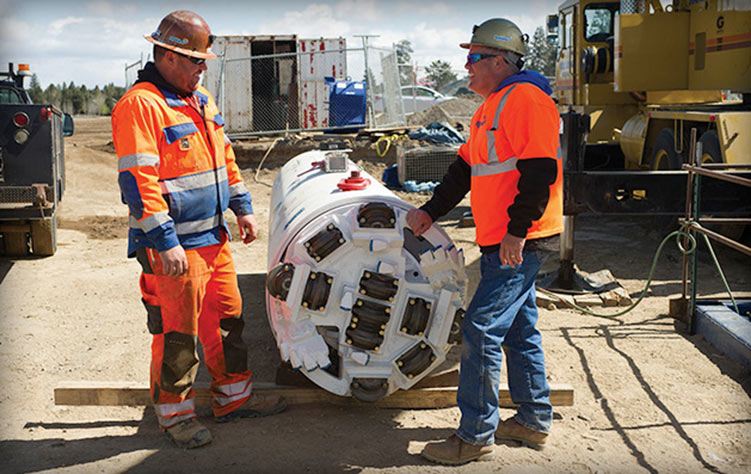Robbins revolutionizes hard rock MTBM design 7 July 2015
A slurry-free prototype remote-controlled Small Boring Unit (SBU-RC) from Robbins has successfully completed its first live demonstration project on US soil.
The machine is being hailed by its manufacturer as a “game changer” in the microtunnelling field. “Finally our industry has provided a small diameter, on-line-and-grade machine that will drill in solid rock at distance. This is a game changer, it will be the most innovative piece of equipment in our industry for a long time,” said Robbins SBU Sales Manager Kenny Clever.
The Robbins SBU-RC is a new type of boring machine capable of excavating small diameter hard rock tunnels at long distances, on-line-and-grade. It is currently manufactured in the 36in (900mm) diameter range, but could be designed as small as 30in (750mm).
It features a smart guidance system for pinpoint steering accuracy and is controlled from an operator’s station on the surface. Muck removal is accomplished through a vacuum system, making the Robbins SBU-RC more cost effective than traditional microtunnelling boring machines (MTBMs) that require slurry and cleaning plants onsite.
The machine recently completed, two weeks ahead of schedule, a critical hard rock crossing below railroad tracks in Bend, Oregon, breaking through on-line-and-grade after achieving up to 50ft (15m) of advance per day in abrasive basalt rock up to 7,000 psi UCS (48 MPa).
Local contractor Stadeli Boring & Tunneling had a unique set of circumstances for a new gravity sewer interceptor. “We had a contract with general contractor Taylor NW to furnish and install 323ft (98m) of 36in (900mm) steel casing under railroad tracks. Line and grade were critical, and the tolerances were very close. We had to be right on,” said Larry Stadeli, President and Owner.
The contractor turned to Robbins, a manufacturer they had worked with many times over the years for supply of SBUs. However, the Oregon job required precision guidance systems that their SBUs lacked. “We met with Robbins in Ohio and told them what our needs were. They felt their prototype machine, which they had tested at one other job in Oman, would be a good fit,” said Stadeli.
The machine selected was equipped with a smart guidance system by TACS, which was capable of showing an operator future projections of the bore path so that steering corrections could be made before the machine was ever out of line and grade. This feature was critical for the crossing below railroad tracks, which could not be shut down if problems occurred.
The SBU-RC operates much like a motorized SBU (SBU-M) with a circular cutterhead and cutting tools that can excavate hard rock or mixed ground conditions. An in-shield drive motor provides torque to the cutterhead, while a pipe jacking system or Auger Boring Machine (ABM) provides thrust.
Clever said of the new design: “There is no manned entry. It eliminates the human element, so it is safer and there is no need for ventilation and other things required when you have a worker in the tunnel. With its guidance system, it also eliminates much of the risk on line-and-grade-critical bores.” Muck removal is accomplished via a vacuum system connected to a vacuum truck. The machine is capable of excavating hard rock and mixed ground crossings up to 500ft (150m) long, depending on conditions.
While microtunneling machines have been used on jobs such as these, Clever cites key advantages for the SBU-RC: “There is no slurry to mix or contend with. With MTBMs the slurry must be cleaned, pumped, and treated. With the SBU-RC there is a clean and dry pit, with no spoil to remove. The way the SBU-RC operates is much more cost effective.”
The SBU-RC was delivered on April 14, 2015, and was lowered into a launch pit 26ft x 8m deep. There were several early tweaks to the set-up including a larger vacuum truck for improved suction, and some modifications to the cutterhead, including grill bars. These modifications will be incorporated into later versions of the machine.
The machine began boring in volcanic basalt rock that was full of fissures, fractures, and rubble pockets, between 5–7,000 psi UCS (34–48 MPa). “As we got used to the machine we went up to 40ft (12m), and one day we even got 50ft (15m),” said Stadeli.
“I think the SBU-RC is an exciting piece of equipment that has been compressed into a 36in size. It’s impressive that the components have been sized down and it still works so efficiently.”
With the clear success in Oregon, Robbins is looking to lease the machine for more projects, and expand the range.
|
|
|
|
|
Add your comment
- Thank you for taking the time to share your thoughts and comments. You share in the wider tunnelling community, so please keep your comments smart and civil. Don't attack other readers personally, and keep your language professional.


